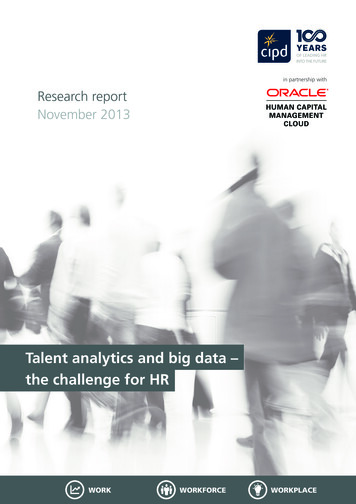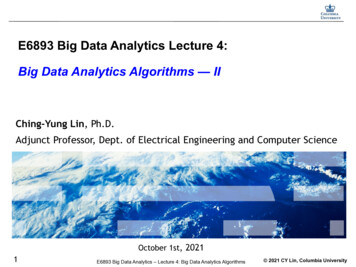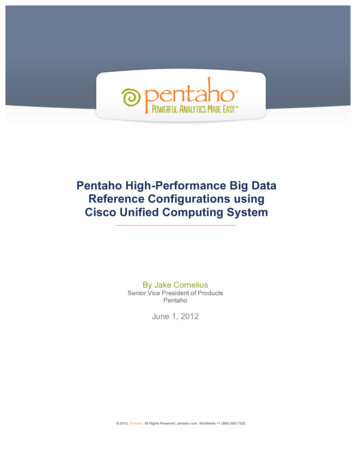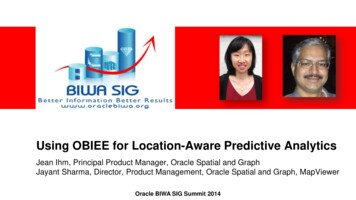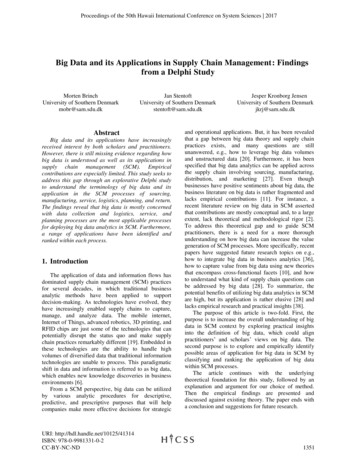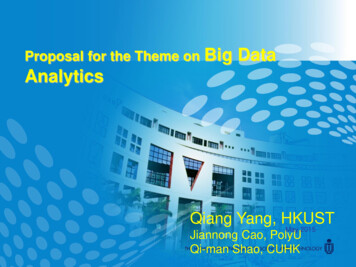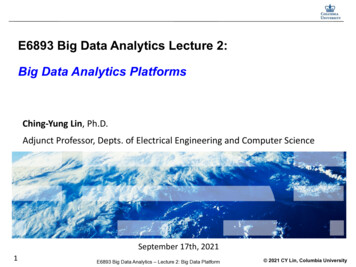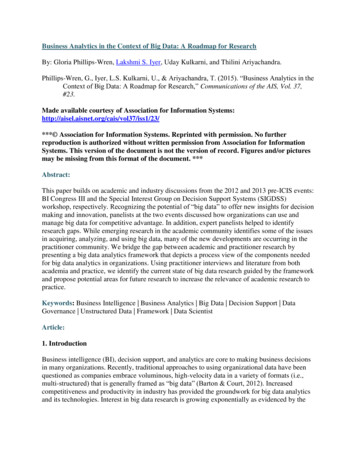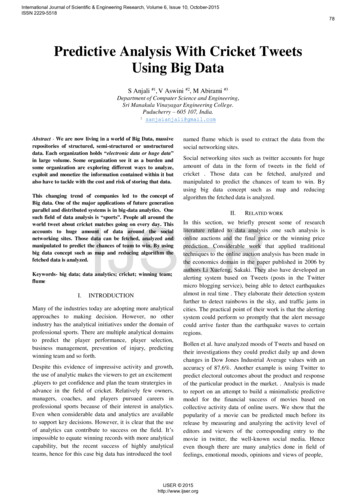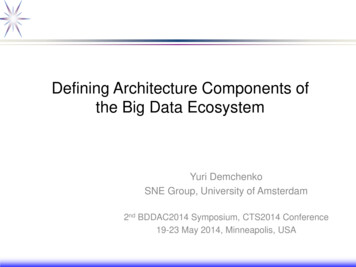
Transcription
1234567891011121314Big Data Analytics in the Smart GridWhite Paper #1 – DraftTopic: Big Data Analytics, Machine Learning and Artificial Intelligence in theSmart Grid: Introduction, Benefits, Challenges and IssuesAuthored by: IEEE Smart Grid Big Data Analytics, Machine Learning andArtificial Intelligence in the Smart Grid Working Group
12CONTRIBUTORS3Working Group on Big Data Analytics, Machine Learning and4Artificial Intelligence in the Smart GridChairLaura L. Pullum IEEE Computer SocietyContributorsAnish Jindal IEEE Communications SocietyMehdi Roopaei IEEEAbhishek Diggewadi IEEE Power and Energy SocietyMerlinda Andoni IEEE (Student)Ahmed Zobaa IEEE Power and Energy SocietyAftab Alam IEEE Power and Energy SocietyAbedalsalam Bani-Ahmed IEEE Power and Energy SocietyYoung Ngo IEEE Power and Energy SocietyShashank Vyas IEEE Power and Energy SocietyRajesh Kumar IEEE Industry Applications SocietyValentin RobuDavid Flynni
StaffPhyllis Caputo IEEE Smart GridAngelique Rajski Parashis IEEE Smart Grid12ACKNOWLEDGEMENT34567891011IEEE Smart Grid Community brings together IEEE’s broad array of technical societiesand organizations through collaboration to encourage the successful rollout oftechnologically advanced, environment-friendly and secure smart-grid networks aroundthe world. As the professional community and leading provider of globally recognizedSmart Grid information, IEEE Smart Grid Community is intended to organize,coordinate, leverage and build upon the strength of various entities within IEEE withSmart Grid expertise and interest. Additional information on IEEE Smart Grid can befound at http://smartgrid.ieee.org.1213141516ii
1iii
1TABLE OF CONTENTS2ABSTRACT. 1341. IEEE SMART GRID BIG DATA ANALYTICS, MACHINE LEARNING AND ARTIFICIAL INTELLIGENCEWORKING GROUP WHITE PAPER SERIES . 252. INTRODUCTION . 36789101112131415161718192021223. CONCEPTUAL DEFINITIONS of BIG DATA ANALYTICS, MACHINE LEARNING, AND ARTIFICIALINTELLIGENCE . 7232425264.275.28References .312930Acronyms .353.1Typical Applications of Big Data Analytics, Machine Learning and Artificial Intelligence in theSmart Grid . 93.1.1 Big Data Analytics Applications . 93.1.2 Machine Learning Applications . 113.1.3 Multi-Agent System Applications . 113.2 The Need for Data Analytics in the Smart Grid . 113.2.1 Cloud Computing . 123.2.2 Edge Computing . 133.3Potential Impact of using Data Analytics in the Smart Grid . 153.3.1 Data Acquisition Framework . 153.3.2 Extracting Value by using Data Analytics . 173.4Security in the Smart Grid . 183.4.1 Cyber-Security Detection . 183.4.2 Cyber-Physical Theft . 193.4.3 Internet of Things and the Smart Grid . 204.14.24.3Overview of Benefits, Challenges and Issues of using Data Analytics in the Smart Grid .22Current and Expected Use . 22Benefits and Impacts . 23Expected Barriers/Challenges/Issues . 26Conclusion .2931iv
12345678910111213141516171819202122232425TABLE OF FIGURES123456789Interaction of roles in smart grid domainsVenn diagram illustrating the interconnectedness of statistics, data analytics,machine learning and artificial intelligenceStatistics, Analytics, Machine Learning and Artificial Intelligence in contextof type of analysis conductedThe features of 5Vs Big Data modelComputing platforms a) Cloud and b) EdgeFramework for data acquisition and analysis in the Smart GridExample of extracting value using BDAMachine Learning and IoT Integration: Utility Management andControl in Smart GridThe evolution of grid analytics and future smart grid in big dataapplications: diverse data sources create high volumes of data andcreate more value489101416172030TABLE OF TABLES12345Smart grid data compliance with the 5Vs Big Data modelFramework for data acquisition and analysis in the Smart GridOther sources of dataNetwork management issuesNetwork management issues and benefits from BDA1016172426v
1ABSTRACT234567891011121314151617The concept of smart grid incorporates a network of generation, transmission and distributioncomponents that undertake power delivery from bulk generation power plants and distributedgeneration to various types of loads. The components are governed and managed by intelligentdevices from generation to consumption, and can be optimized based on environmental andeconomic constraints. A smart grid allows utilities to engage consumers in power generation atthe residential and industrial level, and may implement a bidirectional power exchange. Toenable being “smart”, a huge amount of data is exchanged between grid components and theenterprise systems that manage these components. Based on the application, informationexchanged enables economically optimized bidirectional power flow between a utility and itscustomers. Data exchange is essential for controlling, monitoring and coordination betweensmart equipment in a smart grid subsystem. For optimal performance, big data analytics are anecessity, and local autonomous control is achieved when artificial intelligence is applied usingmachine learning techniques. This paper reviews the applications of big data analytics, machinelearning and artificial intelligence in the smart grid. Benefits, challenges, impacts and problemsof employing these techniques are presented. Some big data analytics approaches forcomputing and transmitting data are detailed.181920Keywords: Smart Grid, Big Data Analytics, Machine Learning, Artificial intelligence, CloudComputing, Edge Computing, Internet of Things, Data Acquisition Framework, Cyber-Security21221
11. IEEE SMART GRID BIG DATA ANALYTICS, MACHINE LEARNING AND2ARTIFICIAL INTELLIGENCE WORKING GROUP WHITE PAPER SERIES345678910111213141516171819This white paper is the first in a series of white papers developed by the IEEE Smart Grid BigData Analytics, Machine Learning and Artificial Intelligence (BDA/ML/AI) working group. Theintent of the series is to provide a concise view into the current status of, benefits of, challengesto, best practices in and standards for BDA/ML/AI in the smart grid.The IEEE Smart Grid BDA/ML/AI White Paper Series will comprise the following white papers:1. Introduction to BDA/ML/AI, Benefits, Challenges and Issues2. Best Practices in Big Data Analytics for the Smart Grid3. Big Data Analytics in the Smart Grid: Recommended Standards, Existing Frameworks andFuture Needs4. Potential Applications and Improvements / Solutions to Issues: A sub-series of applicationand solution-specific white papers organized by IEEE Smart Grid domain and sub-domaincategorization. The intent is to have this subseries of smart grid analytics white paperscover the scope of these domains and subdomains.2
12345678910111213141516171819202122232425262. INTRODUCTIONThe smart grid refers to an advanced communication and information infrastructure thatenables optimization in energy production, transmission, distribution and storage. Otherbenefits involve system management automation, educated planning, lower costs and effort,and electricity system reliability improvement [1]. The characteristics of smart grids involve thewhole spectrum of the power system, from generators and energy suppliers to end-consumers[2]. Smart grids include the ability to enable active customer participation, and facilitateaccommodation of power generation and storage options. A perspective view of the smart gridshows one entity consisting of multiple domains. These domains can be viewed as a chain ofdomains for power service, starting from the generation and ending with the customer.However, these domains are coupled with the help of functional support systems that involvemany aspects of data management and communications, insuring system resiliency andefficiency and subsequently economic and environmental projections. The domain definitionswere adapted by IEEE Smart Grid based on National Institute of Standards and Technology(NIST) definitions [4]. A conceptual model of the smart grid domains and their interactions isshown in Fig. 1.In addition to integration of distributed energy resources (DER), the key drivers for thedevelopment of the smart grid are recent technology breakthroughs in energy storage, electricvehicles (EV) and operation and efficiency improvements required to ensure network resilienceand security of supply. Future energy systems shall include the legacy power equipment withinthe grid infrastructure, with estimates that the US electricity grid will require 2 trillion innetwork upgrades by 2030 [5]. According to the European Commission, the transition towards amore sustainable and secure energy system would require an investment of 200 billion peryear in the EU for generation, networks and energy efficiency developments [3].3
1234567891011Figure 1: Interaction of roles in smart grid domains [12]The bidirectional flow of electricity and information is an essential field in the smart grid. Withthe growing electricity supply from smaller-scale, decentralized generators, i.e., wind farms andresidential rooftop photovoltaics (PV) panels, and microgrids, advanced sensor and meteringtechnologies with integrated security protocols allow for envisioned advanced features of thesmart grid, such as demand response, autonomous control, self-healing and self-configuration4
03132333435363738[6]. Essentially, the smart grid provides significant improvements to traditional power systemsthat include six essential building blocks, namely, network, user, hardware, software, serversand data [7].These characteristics make it challenging for traditional analysis, but ideal for the application ofartificial intelligence, machine learning techniques and big data analytics. In this paper, we willuse the term Big Data Analytics (BDA) to refer to the collective data analytics, machine learningand AI. The objective of BDA is to investigate the very large volumes of data produced byvarious components in the smart grid, and transform the data into meaningful inputs such aspatterns of operation, alarm trends, fault detection, and control commands. For example,advanced machine learning applications for distribution transformers analyze the dataaggregated in real-time for each transformer. The outcome of these learning applications mayidentify some operating trends leading to failure patterns of these devices and help anticipatefuture failures, and consequently, provide timely and accurate insights for predictivemaintenance.Research efforts in smart grid deployments have focused on advanced metering infrastructure(AMI), such as smart meters, communication, information, control and energy managementsystems for utilities and consumer-based equipment (e.g., smart home energy controllers andbuilding monitoring systems). Moreover, other application areas include the integration ofautomation, control and real-time monitoring of advanced sensors and monitoring equipment.This can be accomplished with field devices, such as phasor measurement units and intelligentelectronic devices (IED), at the transmission level and automated feeder switches, and networkprotection relays, voltage regulators, and capacitor controllers at the distribution level. Theseactions aim to enhance power system performance and diagnostics that will lead to costreduction.A significant portion of the smart devices being deployed is related to the massive rollout ofsmart meters currently taking place in many countries. The number of smart meter readings fora large utility company is expected to rise from 24 million a year to 220 million per day [7].Approximately 22GB of smart meter data is being generated by 2 million customers per day [8].Assuming that an application requires data collection in 15 minute intervals, 1 million deviceswould result in 35.04 billion data entries with a total volume of 2920 Tb per year [7]. The otherportion of smart grid devices relates to cutting-edge network devices, such as IEDs beinginstalled in power system networks to monitor key network parameters and generation andconsumption in real time, control power flows, exchange information with each other and havelocal decision-making capability.5
1234567891011121314151617Traditional approaches of data analysis are inadequate to cope with the high volume andfrequency of data generated within the smart grid paradigm by various distributed sources. Thismakes optimization and smart management challenging and computationally intensive. Dataare generated by multiple heterogeneous sources including sensors, IEDs, smart meters, smartappliances, distribution automation data, third-party data, asset management data andweather station data playing an increasingly important role for managing intermittent DERs [7].Data need to be transformed into actionable insights by applying high volume datamanagement and advanced analytics (i.e., BDA) [9]. Essentially, BDA represents advancedanalytics, such as predictive analytics, data mining, statistical analysis, machine learning and AItechniques, which operate on large data sets having one or more features of big data [10].Local and distributed control architectures can provide solutions that can reduce the datatransmission load and computational resources required, as opposed to centrally controlleddecision-making. BDA techniques can provide solutions as the complexity of the power systemcontinues to grow [11].6
03132333435363. CONCEPTUAL DEFINITIONS of BIG DATA ANALYTICS, MACHINELEARNING, AND ARTIFICIAL INTELLIGENCEBefore moving forward, we need to understand several terms which are interrelated (asillustrated in Fig. 2) and commonly used in different contexts while performing analytics in thesmart grid. These terms are:Statistics: It is the study of the collection, analysis, interpretation, presentation, andorganization of data. Further, it can also be defined as the mathematics of estimatingparameters of populations based on data from different representative samples of thosepopulations. In statistics, the standard procedure for statisticians is to start with a nullhypothesis (a default position that there is no relationship between two quantities) which iscompared with an alternate hypothesis (a position that states there is a relationship betweentwo quantities). The decision to reject a hypothesis is taken on the basis of various statisticaltests which are performed on different population samples.Data Analytics: It is the discovery and communication of meaningful patterns in data [13]. Dataanalytics is a (sometimes automated) process used to discover novel, valid, useful andpotentially interesting knowledge from large data sources which is otherwise difficult touncover. If statistics is to be considered a branch of mathematics, data analytics is inclinedtowards performing the same functionality for computer science. Visual tools and techniquesare the preferred means of communicating the results of performing data analytics.Machine Learning: It is the ability of machines (associated with computers) to learnautomatically without being explicitly programmed. It deals with representation andgeneralization of data and creates a representation of instances and functions which areevaluated on these data. Generalization is the unique property that the machine learningsystems will try to yield, that is, the ability of the systems to perform well even on unseen datainstances.Artificial Intelligence: It is the intelligence exhibited by machines, as opposed to naturalintelligence exhibited by humans or animals. AI encompasses techniques which can endow anobject or a program with human-like intelligence. AI also includes intelligent agents, entitiesthat perceive their environment and take actions based on that perception.7
1234567891011121314151617181920212223Figure 2. Venn diagram illustrating the interconnectedness of statistics, data analytics, machinelearning and artificial intelligence.The purpose of different types of analytics change as we move along the continuum of value(Fig. 3) as follows: Descriptive analytics aim to provide information about what happened and it comprisesthe first step that tries to identify useful information/data for further processing. Itmight include data visualization, data mining or aggregation of reports. Diagnostic analytics aim to understand the cause of events and system behavior andtries to identify challenges and opportunities. Predictive analytics are used to make probabilistic predictions to identify trends with theaim to determine what might happen in the future. Prescriptive analytics are applied to identify the best outcome to events, given thesystem’s parameters, and draw strategies to deal with similar events in the future. Ituses tools such as simulation techniques and decision support to explore optimalstrategies to best take advantage of a future opportunity or to mitigate a future risk[14].8
12345Figure 3. Statistics, Analytics, Machine Learning and Artificial Intelligence in context of type ofanalysis conducted. (Adapted from [15])6789101112131415163.1Typical Applications of Big Data Analytics, Machine Learning and ArtificialIntelligence in the Smart Grid171819203.1.1 Big Data Analytics ApplicationsData generated in the smart grid are difficult to handle with traditional analysis techniques toproduce actionable information within useful timeframes, as required by the nature of smartgrid operations. Smart grid data can be classified as big data according to the 5Vs (Volume,To illustrate how big data analytics, machine learning and artificial intelligence are used in thesmart grid, this section provides examples of typical applications relevant to the smart grid.These examples are provided as illustration and are, in no way, comprehensive. Section 4 listsadditional expected smart grid-relevant applications. At present, there is a lack of typicalapplications of artificial intelligence in the smart grid beyond the application of ML. However,there are a growing number of new models, e.g., deep learning and reinforcement learning,that show promise towards enabling AI use in the smart grid.9
12345Velocity, Variety, Veracity and Value) model shown in Fig. 4. Smart grid data exhibits eachfeature of the model as described in Table 1.6789Figure 4: The features of 5Vs Big Data model [7]Table 1 Smart grid data compliance with the 5Vs Big Data model [7]FeatureVolumeVelocity5Vs ModelNumber of records and requiredstorageFrequency of data generation,transfer or collectionVarietyDiversity of sources, formats,multidimensional fieldsVeracityReliability and quality of dataValueExtracting useful benefits andinsightsSmart GridHigh volumes of data from smart meters andadvanced sensor technologyIf smart meter data are collected every 15minutes, 1 million devices result in 35.04 billiondata entries or 2920 Tb per year [7]. Thefrequency data are collected is crucial for realtime monitoring and analysis.Existence of structured (e.g., relational data),semi-structured (e.g., web service data) andunstructured data (e.g., video data)Reliable data are crucial to ensuring safesystem operation and stability.Applications derive value from smart grid data,e.g., predicting future generation and demand.101110
1234The results of big data analytics can be used to predict and understand end-consumer behavior,to improve network resilience and faults, to enhance security and monitoring, to enhanceperformance and to optimize available resources and future planning.567891011121314151617183.1.2 Machine Learning ApplicationsMachine learning algorithms are particularly used for clustering data gathered from the smartgrid domain [16]. Data are clustered to form groups with similar characteristics (naturalclassification), e.g., grouping together data points with similar active/reactive power profiles fortransmission system operator (TSO) studies. Other examples include identifying low voltage(LV) feeders with similar load patterns for distribution system operator (DSO) studies to becompressed or summarized into cluster prototypes (e.g., generating representative days forwind production and their inclusion into network simulations). Further, ML can use smart griddata to understand the underlying structure, to gain useful insights, detect anomalies andgenerate hypotheses, etc. (e.g., detect theft and understand user consumption behavior at aparticular feeder). Predictions play a significant role in power systems as they are typically usedto plan future aggregated electricity demand, future system supply, estimating flexibility andreserve services requirements or operational management of distribution networks.19202122232425262728293031323.1.3 Multi-Agent System ApplicationsAn application of AI in the smart grid context is multi-agent system (MAS) modelling. As thepower system becomes more decentralized, market-oriented, multi-variable and complex,control and decision-making through a centralized approach becomes challenging as it requiressignificant computational power to determine optimal decisions for the entire system withoutsignificant delays. An improved approach is to divide the power system into more autonomousunits that can make some of the decisions locally, following decentralized or distributedcontrol. MAS approaches can be used to solve complex problems in an efficient, scalable anddistributed way [17]. Potential applications of MAS in the context of the smart grid include thecontrol of microgrids, fault management and disturbance diagnosis, self-healing and powerrestoration, voltage control, frequency control, demand side management based on agentarchitecture, energy consumption optimization and scheduling and coordination of storagedevices.3334353637383.2 The Need for Data Analytics in the Smart GridThe smart grid gathers data from diverse sources and stores it to be consumable by analytics.Managing smart grids to provide smart energy requires advanced machine learning techniquesto collect accurate information in an automated fashion, automate decision-making and controlevents in a timely manner at both the local and system-wide level. Important progress has been11
03132333435363738made for using field data acquired from smart devices mounted in substations, feeders, andnumerous databases and models across the utility enterprise. There are several sources of datain smart grids on markets, equipment, geography and power system data which can be used topredict states, provide situational awareness, analyze stability, detect faults and provideadvance warning. Therefore, analytics (comprising BDA, ML and AI) have a significant role tomake the grid more intelligent, efficient and productive. Analytics can be applied to signal,event, state, engineering operations, and customer analytics, in sum enabling high-level anddetailed insights into grid situational awareness. There are several types of analytics models,namely descriptive, diagnostic, predictive, and prescriptive models (recall Fig. 3). These can beapplied for the smart grid, for instance, descriptive models describe customer behaviors fordemand response programs. Diagnostic models are used to understand specific customerbehaviors and analyze their power-related decisions. Each type of model can provide valuableinput to create models that predict future customer decisions and hence, power needs. Finally,prescriptive models can provide high level analytics to influence smart grid marketing,engagement strategies and decision making.Power systems are required to evolve for dynamic and flexible interaction with consumersparticipating in the electricity markets, LV control automation, distribution management system(DMS) integration, microgrid control and balancing, proactive fault identification, self-healingand resource optimization. Smart grid systems are becoming increasingly complex andinterconnected, exhibiting characteristics of a “system of systems”.As explained above, energy systems need to evolve to account for distributed power generationand the dynamic processes of demand management, load control and energy storagemanagement. The energy system is currently experiencing significant changes, due to changesin regulatory frameworks and policies that relate to sustainability. This has resulted insignificant growth in the volume, variety and velocity of data, a significant increase instakeholder number and diversity, but also providing new business opportunities for improvedeconomics and reliability. The need for data analytics and novel technologies is relevant toevery stakeholder of the energy system, including the system operator, market operator,regulator, service provider, consumers, transmission and distribution system operators andservice providers and generators.3.2.1 Cloud ComputingCloud computing provides the ability to connect to software and data on the cloud (theInternet) instead of a local computing network or a local hard drive. It is the most recentsuccessor to virtualization, cluster computing, utility computing, and grid computing. Cloud12
omputing centers largely on the outsourcing of computing needs and storage to cloudservices. It is a system where users can connect to a vast network of computing resources, dataand servers that are available usually on the Internet.3031323334353637383.2.2 Edge ComputingVirtualization is the foundation of cloud computing. Cloud computing, as defined by Forrester[18] is given as a pool of abstracted, highly scalable, managed compute infrastructure capableof hosting end-customer applications and billed by consumption. The key feature of cloudcomputing is that both the software and the information are stored on the massive network ofcloud servers rather than on an end-user’s computer. Cloud computing is a reliable choice forperforming analytics as it has abundant resources accessible anywhere and at any time.There are many cloud computing platforms, like those offered by Amazon Web Services, AT&T’sSynaptic Hosting, and to an extent, the HP/Yahoo/Intel Cloud Computing Testbed, and theIBM/Google Cloud. The grid can be made to run more efficiently by using cloud platforms v.massive local networks.The opportunities and challenges of emerging and future smart grids can also be assisted bycloud computing. The advantages of using cloud computing are: Self-service on-demand: The user can individually provision computing capabilities asneeded. Human interaction with each service provider is not required, as the service isprovided automatically. Broad network access: Capabilities are available over the network. It can be accessedthrough standard internet access mechanisms. Swift elasticity: Cloud computing also supports the elastic nature of memory devicesand storage. Depending on user demand, it can expand and contract. Measured service: Cloud computing also offers metering infrastructure to users. Usersare thus able to provision and pay just for their consumed resources.In relevance to the smart grid, the Internet of Things (IoT) is a concept that brings largeamounts of data generated by an embedded component of a variety of devices, sensors andnetworked entities. Forming a subsystem of the smart grid, these devices may be bundled in acyber manner in order to ag
IEEE SMART GRID BIG DATA ANALYTICS, MACHINE LEARNING AND 2 ARTIFICIAL INTELLIGENCE WORKING GROUP WHITE PAPER SERIES 3 This white paper is the first in a series of white papers developed by the IEEE Smart Grid Big 4 Data Analytics, Machine Learning a


